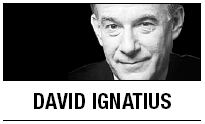WASHINGTON ― The “Arab Spring” has analysts searching for the right historical comparison. Is it like 1848, and the wave of revolution that swept Europe? Or is it 1989 and the fall of the Berlin Wall? Or perhaps 1979, and the toppling of the Shah of Iran by Muslim radicals?

The democratic uprising of 2011 has elements of all of the above, and the spirit of change mostly has been exhilarating. But the loudest noise I hear from the Middle East just now isn’t from the barricades but from frightened leaders who say, with the desperation of the French army retreating in disarray at Waterloo in 1815: “Sauve qui peut!” Save yourself if you can!
The 1815 analogy is useful because it reminds us that an old structure of power ― a hegemonic system dominated by the United States ― is coming apart as the world changes, and that a new framework will have to be built to maintain stability. In 1815, that process of adjustment led to the Congress of Vienna and a new security architecture ― a woolly but important topic to which I will return.
Back to the politics of self-preservation, circa 2011: The tactics vary, country by country. Some Arab leaders (notably King Abdullah II in Jordan) are encouraging political change, in the hope they can build new legitimacy; others (Moammar Gaddafi in Libya and, lately, Bashar al-Assad in Syria) are using military force to brutalize their people into submission. The brutalizers may gain a few weeks’ breathing space through intimidation, but Assad and Gaddafi are likely to fail. They have delegitimized themselves by firing on their own citizens.
The backdrop of this frantic self-preservation is the breakup of America’s reluctant empire. The kings and presidents (not to mention people in the streets) saw in Egypt that the United States wouldn’t rescue its clients. Exhausted by Iraq and Afghanistan (and perhaps also made wiser by these wars), America wasn’t in the business of saving autocratic dictators.
America’s abandonment of President Hosni Mubarak shocked Israelis, Saudis and other status-quo powers, but it was actually just an admission of reality. When you have a million people in Tahrir Square who are prepared to die for a cause, no foreign or domestic power can stop them.
In these moments when old alignments come apart, it’s important that newly liberated countries have some reference point: After 1989, Eastern Europe could look to the European Union for a political-economic model, and to NATO for security guaranties. After the Ottoman Empire collapsed in 1918, the British and French mandates briefly administered the pieces of the Ottoman quilt; and when those mandates ended after 1945, a rising America offered hegemony, and a rising Israel imposed constraints.
Right now, we’re between two systems. The old one that accommodated Mubarak and Gaddafi is finished, but there’s no successor yet. In this political vacuum, leaders are jockeying for position ― often going in two directions at once. Jordan’s king sympathizes with democratic reformers in Bahrain, for example, but he’s also moving to join the Saudi-led Gulf Cooperation Council that sent troops to Bahrain. Saudi King Abdullah is so peeved at America’s abandonment of Mubarak that he sent Prince Bandar as an emissary to China and other Asian nations to seek new allies. But the Saudis still work closely with the CIA against terrorism and with Centcom on military security.
In addressing all this upheaval, President Obama must focus on basic values: How can the United States support nonviolent change, and oppose the regimes that are using violence to suppress their people? How can the old narrative of rage that was Osama bin Laden become a new narrative of hope and self-reliance?
If Obama wants to take on a big, gnarly topic, he should ponder the analogy of 1815. That was the subject of Henry Kissinger’s doctoral dissertation (published in 1954 as “A World Restored”) and the topic is newly relevant. As Kissinger explained, the far-sighted statesmen of the Congress of Vienna found a way to reconcile the interests of the status-quo powers of the day (Britain and Austria) with the rising powers (post-revolutionary France, Prussia and Russia).
Power abhors a vacuum, such as the one that exists now. We may be entering a “post-American” age in the Middle East, but that doesn’t mean that the United States shouldn’t be working with its allies to create a more inclusive security architecture that’s worthy of this time of transformation. A world restored, indeed.
By David Ignatius
David Ignatius’ email address is davidignatius@washpost.com ― Ed.
(Washington Post Writers Group)








